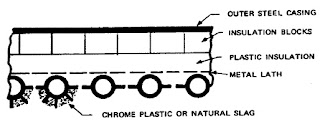Construction of water wall tubes must provide high quality of the supporting component such as tubes, casing, refractory, lagging, tile, fin, and so on. Best construction will reduce heat loss and maintenance. Construction of water wall tubes can be classified into four types such as:
 |
| Figure 1: Tube and Tile Water Wall Source: See Reference |
1. Tube and Tile Water Wall
At the first development of steam boiler, the designer use this type because of limitation of factory or workshop capability to make tubes are rolled into header, water drum or steam drum, so the spacing between tubes is not designed well practically. The effect of this condition is the furnace can not give enough heat transfer surface (see figure 1)
 |
| Figure 2: Tangent Tube Water Wall Source: See Reference |
2. Tangent Tube Water Wall
Tangent tube water wall type is similar with tube and tile water wall type but the amount of heat transfer is higher than tube and tile water wall because of higher amount of tubes in this type. But the problem is same with tube and tile water wall type, it is the limitation to give protection in the refractory because it is directly contacted with burner or combustion process (see figure 2).
 |
| Figure 3: Studded Tube Water Wall Source: See Reference |
3. Studded Tube Water Wall
This type is continuous development from the above type. The advantage of this type is can give higher efficiency because the construction of studded tube water wall protects refractory effectively. If the corrosion attack the lagging and tubes, so leakage will occurs when flue gas flow through the water wall(see figure 3).
 |
| Figure 4: Membrane or Fin Tube Water Wall Source: See Reference |
4. Membrane or Fin Tube Water Wall
Membrane or fin tube water wall is now best design and construction because this type can give more protection in the insulation and give highest efficiency and heat transfer surface (see figure 4).
Reference:
No comments:
Post a Comment